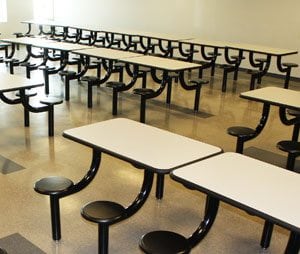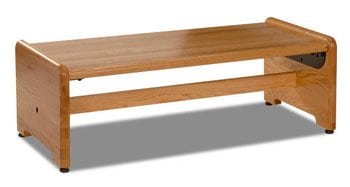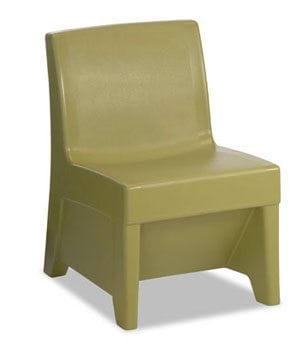5 Table Considerations for Employee Dining Rooms
 Employee dining rooms and break rooms can be much more than just a spot for workers to scarf down their food, wash their hands, then return to work. Most likely, your employees would like these areas to also be a place where they can relax, recharge and socialize with co-workers while they are away from the desk, their post or their spot on the line.
Employee dining rooms and break rooms can be much more than just a spot for workers to scarf down their food, wash their hands, then return to work. Most likely, your employees would like these areas to also be a place where they can relax, recharge and socialize with co-workers while they are away from the desk, their post or their spot on the line.
However, when planning your employee dining room, it’s not always as easy as heading down to your local furniture store and picking out pieces that you feel fit your environment. Employee dining areas are constant-use spaces and therefore are put up against a lot of wear and tear. Furniture in these environments needs to be highly durable while still fulfilling your basic need to accommodate employees with a comfortable dining space. And for those companies that care about aesthetics, finding nice-looking furniture that is also highly durable creates even another challenge when looking for the right product.
Below, we outline five important considerations for picking tables for your employee dining areas.
Legs and Support Materials
As much as you respect your employees and what they do for your facility, the fact is that they probably aren’t going to treat your employee dining room furniture as nicely as they would their home furniture. To ensure your tables stand up to constant use, be sure to select tables that have leg and supportive pieces made of superior materials.
 For example, Norix’s Oasis Series of cafeteria tables (photo, right) are supported by legs and support beams made of 14-gauge, 2-inch steel tubing that is fully welded to a 10-gauge, 7 x 17-inch steel plate with reinforced gussets that are connected to the tables’ laminate tops. This reinforcement ensures that tops don’t become separated from their legs/support materials and that the legs themselves don’t break.
For example, Norix’s Oasis Series of cafeteria tables (photo, right) are supported by legs and support beams made of 14-gauge, 2-inch steel tubing that is fully welded to a 10-gauge, 7 x 17-inch steel plate with reinforced gussets that are connected to the tables’ laminate tops. This reinforcement ensures that tops don’t become separated from their legs/support materials and that the legs themselves don’t break.
Another example is our Madera leg style tables which include legs that are 2.5 or 4 inches in diameter and are made of 14-gauge steel tubing that is welded to a 6″ x 6″ x 1/4″ steel plate that is attached to the tabletop with bolts that are embedded through permanent T-nuts that provide a metal-to-metal connection. This is more secure than fasteners going straight into wood which can lead to the holes becoming bored out and the connection becoming loose. Heavy material, welding, the addition of steel attachment plates and metal-to-metal fastener connections ensure that these tables stand up to the toughest of environments.
Tabletops and cleanability
In most cases, busy employees don’t have time to get out the surface cleaner and clean after themselves after lunch. But your cleaning staff still has to deal with it. And cleaning the surface is just part of keeping a tidy employee break room. You also need to keep in mind sanitation and other health issues. Tables for employee dining areas need to come equipped with tops that are made of materials that are scratch-resistant and fluid resistant, easy to clean, and durable enough to take the wear and tear of constant use.
Again, our Oasis table is perfect for these areas and provides safeguards against grime, food residue and sanitation issues. These tables are made of decorative, high-pressure laminate tops that are sealed with a specially formulated, highly durable molded edge. This kind of material makes your typical spills and messes easily cleanable using soap and water. Additionally, Oasis table edges are radiused for safety and pressure-fused to the top, rendering it non-removable and highly sanitary. This means the edges are permanently molded to the table, making it impossible for food parts, liquids and bodily fluids to become lodged between the edge and laminate top. Typical edge banding often becomes separated from the tabletop which creates a crevice that can become packed with dirt until it eventually peels off and requires facilities to replace the table.
Configurability
Does your employee dining room double as a meeting room on occasion? Or is there an annual holiday potluck that requires tables to be moved around? Configurability is a highly important consideration before you have your tables installed. Maybe most important is whether you bolt down or leave your tables freestanding. Leaving your tables freestanding allows you to move the tables around to meet different needs as they become necessary. This allows you to line up several tables together to make one long table and to push tables to the side if you need an open area in the room for a presentation.
But your employees can move the tables, too. And if they do move the tables, your maintenance or cleaning staff will have to move them back in order to keep the room orderly. Bolting the tables down to the floor can prevent this, but this method of security has its pros and cons as well. Once tables are attached to the floor they cannot be moved. This is a nice option for facilities that need to keep tables exactly in one place. However, once bolted down, the tables can’t be configured in any other fashion. Bottom line, ask yourself: What functionality do I need from this space?
Aesthetics
Does a happy workplace equal happy workers? Probably not in all cases. But making an aesthetically pleasing employee break room no doubt will have a positive impact on those who use it. That is why picking tables with aesthetically pleasing design and colors should be considered. For example, our Forté Café table has a top that is made with high-pressure laminate that is sealed with a specially formulated, highly durable molded edge. Aesthetically speaking, the laminate comes in three colors that resemble wood, therefore giving it a residential feel while remaining highly durable.
 Or, take for example our Sierra Series coffee table (photo, right), which is made with 1 3/4″ thick butcher-block red oak that is rounded for safety and comes with a sealer coat and satin finish coat to protect the wood. Pieces like this not only have the durability for continuous-use environments but also the aesthetics that make this series popular in waiting areas, student unions and residential settings. So while industrial-style furniture is always an option, do know that there are products out there that are highly durable AND pleasant to look at.
Or, take for example our Sierra Series coffee table (photo, right), which is made with 1 3/4″ thick butcher-block red oak that is rounded for safety and comes with a sealer coat and satin finish coat to protect the wood. Pieces like this not only have the durability for continuous-use environments but also the aesthetics that make this series popular in waiting areas, student unions and residential settings. So while industrial-style furniture is always an option, do know that there are products out there that are highly durable AND pleasant to look at.
Seating for your tables
When it comes to seating, there are three standard options for most employee dining areas: fixed, swivel and free standing. Fixed seating is perfect for environments that require seats that don’t go ANYWHERE. Fixed seating tables – like our Max Master series – usually feature seating that is adjoined to tabletops and to the floor via tubular steel, rendering the seats immovable. This might not be the most comfortable option, but it provides extreme safeguards from damage, wear and movement. Swivel seats, too, are attached to the floor and table with tubular steel. However – as the name suggestions – the seats can move horizontally from left to right, for easy access and egress.
 The most flexible seating for employee tables are freestanding chairs. These chairs are not attached to the tables at all and can be moved around and in many cases stacked. For example, our Forté Guest Chairs (photo, right) provide comfortable support, are easy to clean and are made especially to pull up to our Forté Café table.
The most flexible seating for employee tables are freestanding chairs. These chairs are not attached to the tables at all and can be moved around and in many cases stacked. For example, our Forté Guest Chairs (photo, right) provide comfortable support, are easy to clean and are made especially to pull up to our Forté Café table.
Additionally, our Integra armless chairs are made of high-impact, fire-retardant polypropylene. They can withstand a static load test of more than 400 pounds and weigh only 7 pounds. This chair can be stacked or pulled away from the tables and lined up in rows in the case that a facility needs seating for a speaker or presentation. An option such as this gives facility the maximum flexibility and freedom, while also providing extreme security, durability and cleanability.
Conclusion
When purchasing furniture for employee dining rooms, ask yourself these questions: What are the most important requirements for this space? Is it security? Comfort? Aesthetics? Is it all of these? Take what we have shared with you in this blog post and ask your furniture manufacture to make recommendations as well. Your employees will appreciate the fact that you kept them in mind when you made these spaces the kind of environments that they will actually want to spend time in.
Dustin Coleman is a brand journalist for Norix Furniture and a contributor to the Safe Environments blog.